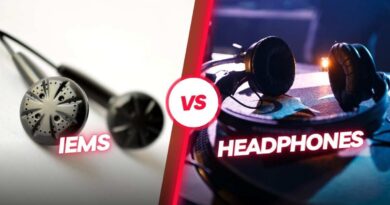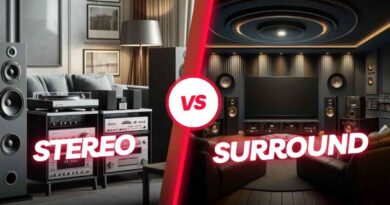Studio Headphones vs. Gaming Headphones: The Difference
In my extensive experience as an audio expert, I’ve frequently encountered the debate between studio headphones and gaming headphones. Each type is engineered with specific user needs in mind, which makes them suitable for different applications. This blog will provide an in-depth analysis of both, exploring their designs, functionalities, specifications, and suitable use cases to help you determine which is best suited for your audio requirements.
Understanding The Basics: Studio Headphones
Studio headphones are crafted for precision and critical listening. They are an essential tool for audio professionals who require an accurate reproduction of sound to make meticulous adjustments to audio tracks.
Flat Frequency Response: The Core of Studio Headphones
A key feature of studio headphones is their flat frequency response. This means the headphones can reproduce audio signals without coloration; in other words, no frequencies are artificially boosted or suppressed. This accuracy is crucial for professionals who need to hear music or audio tracks exactly as they are recorded to make precise adjustments.
- Neutral Sound Signature: The sound is not altered to enhance the listening experience, making it possible for professionals to identify and correct any issues in the recording.
- Critical for Mixing and Mastering: Allows producers and engineers to create a final product that sounds good on any playback system.
Build Quality and Comfort
Professionals often wear headphones for extended periods, so comfort and durability are paramount. Studio headphones are designed with high-quality materials to withstand the wear and tear of studio use. They usually feature plush ear pads and an adjustable headband to ensure they can be worn for long sessions without discomfort.
- Robust Construction: Often made with durable materials to endure the demanding environment of a studio.
- Comfort for Long Sessions: Extra padding and careful weight distribution ensure they remain comfortable throughout long studio sessions.
Importance of Sound Isolation
Sound isolation in studio headphones helps prevent outside noises from interfering with the critical listening process. This feature is especially important in loud environments, like when tracking a live band. Both closed-back and open-back designs have their place in studio work, depending on the specific needs of the audio task.
- Closed-Back Design: Excellent for recording as they prevent sound from leaking into the microphone.
- Open-Back Design: Used in mixing environments to provide a more natural sound stage, which helps with the spatial representation of audio.
Exploring Gaming Headphones
Gaming headphones are not just about delivering sound but enhancing the gaming experience through features like surround sound, integrated microphones, and customization options tailored to gamers’ needs.
Enhanced Audio Features for Immersive Gaming
Gaming headphones often emphasize sound profiles that enhance gameplay. This includes boosted bass to make explosions feel more powerful or sculpted highs to hear footsteps and other in-game sounds more clearly. Virtual surround sound is also common, helping players discern the direction from which sounds are coming—a critical feature in many competitive games.
- Surround Sound Capabilities: Essential for immersive experiences and competitive play where spatial audio cues are crucial.
- Enhanced Bass and Sculpted Highs: Make in-game sounds more dramatic and easier to distinguish.
Design Features Geared Towards Gamers
Gaming headphones often feature eye-catching designs and built-in comfort features that cater to long gaming sessions. Many models include breathable materials and adjustable components, ensuring they can be customized to fit any user comfortably. Additionally, aesthetic elements such as RGB lighting are popular, allowing users to synchronize their gear with their gaming setup.
- Visual Appeal with RGB Lighting: Enhances the gaming setup with customizable colors and effects.
- Ergonomic Features for Long-Term Comfort: Special padding and weight distribution for hours of comfortable use.
Integration with Gaming Ecosystems
A critical aspect of gaming headphones is their compatibility and integration with gaming platforms—PCs, consoles, and mobile devices. This includes not only the ability to connect via various interfaces like USB, 3.5mm jack, or wireless but also compatibility with platform-specific features such as chat functionalities and on-the-fly audio controls.
- Multi-Platform Compatibility: Ensures that headphones can be used with various devices.
- User Interface for Audio Control: Allows gamers to adjust settings quickly without leaving the game.
Studio Headphones vs. Gaming Headphones
In-depth Comparison: Specifications and Use Cases
To understand the fundamental differences between studio and gaming headphones, it’s important to compare their specifications. Studio headphones typically have larger drivers that offer better response across a wider frequency range, essential for detailed audio work. In contrast, gaming headphones might have smaller, more responsive drivers that prioritize frequencies common in sound effects and game tracks.
Frequency Response and Driver Size
- Studio Headphones: Wider frequency range for a more detailed audio profile.
- Gaming Headphones: Frequency response tailored to enhance gaming sounds like footsteps, gunfire, and explosions.
Soundstage and Imaging
Soundstage and imaging are crucial for different reasons in each type of headphone. Studio headphones need a precise soundstage for accurate placement of instruments in mixes. Gaming headphones benefit from a good soundstage to enhance the perception of an immersive environment, which is crucial for gameplay realism.
- Studio Headphones: Accurate imaging for professional audio editing.
- Gaming Headphones: Wide soundstage for immersive gameplay experiences.
Pros and Cons – Studio Headphones vs Gaming Headphones
- Studio Headphones
Pros:
- Accurate sound: Designed for neutral, uncolored sound reproduction, ideal for critical listening in music production and mixing.
- Durability: Built to last with quality materials for professional use.
- Comfort: Often lightweight and comfortable for long listening sessions.
Cons:
- Microphone: Usually don’t have a built-in microphone, so you’ll need a separate one for gaming communication.
- Noise isolation: May not have the best noise isolation, which can be a drawback in noisy environments.
- Features: Lacks features like surround sound that can enhance gaming immersion.
- Gaming Headphones
Pros:
- Immersive sound: Often have surround sound or audio features tuned to emphasize sounds like footsteps in games, giving you a competitive edge.
- Microphone: Almost always have a built-in microphone for easy communication with teammates.
- Noise isolation: Many have good noise isolation to block out distractions.
- Comfort: Designed for comfort during extended gaming sessions, often with plush ear cups.
Cons:
- Sound quality: Sound may be colored or bass-heavy, which isn’t ideal for critical listening.
- Durability: Materials might not be as high-quality as studio headphones.
- Price: Can be expensive for high-end models with all the bells and whistles.
Conclusion
Choosing between studio and gaming headphones should be based on your primary use case. If you’re involved in music production, mixing, or any form of professional audio work, studio headphones are indispensable for their accuracy and detail. For gamers, gaming headphones not only offer high-quality audio but also bring game-enhancing features like integrated microphones and surround sound.
Both types of headphones excel in their respective fields, and the best choice depends on what you need most from your audio equipment—precision or immersion.
Frequently Asked Questions
Are studio headphones suitable for casual listening?
Yes, studio headphones can be excellent for casual listening, offering high fidelity and accurate sound reproduction.
Can gaming headphones be used for movie watching?
Absolutely, gaming headphones provide an immersive audio experience with their enhanced bass and surround sound features, making them great for movies.
What is the typical impedance in studio headphones?
Studio headphones often have higher impedance, usually around 250 ohms, to ensure compatibility with professional equipment.
Do gaming headphones require additional software?
Many gaming headphones come with software to customize sound profiles and settings, enhancing the gaming experience.
What is the average cost of high-quality gaming headphones?
High-quality gaming headphones can range from $50 to $300, depending on the brand and features.
How should I clean my headphones?
Cleaning involves gently wiping the ear pads and headband with a soft, dry cloth and using sanitizing wipes designed for electronics.
Can I replace parts on my studio headphones?
Many high-end studio headphones have replaceable parts, allowing for easier maintenance and longer lifespan.
What warranty should I expect with gaming headphones?
Warranties can vary, but most reputable brands offer a 1-2 year warranty on gaming headphones.
Which type of headphones is better for traveling?
For travel, noise-canceling headphones are often preferred, which can be found in both studio and gaming varieties, depending on your needs.




